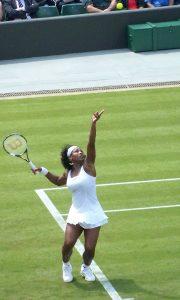We may earn money or products from the companies mentioned in this post.
What Is A Default In Tennis?

In the world of tennis, a default refers to a situation where a player is unable to continue or participate in a match It can occur voluntarily or involuntarily, depending on the circumstances and reasons behind it
Voluntary Default
A voluntary default happens when a player willingly chooses not to continue with the match This could be due to various reasons, such as injury, illness, or personal circumstances that prevent them from playing at their best In some cases, players may also choose to default if they feel that continuing would aggravate an existing injury
Involuntary Default
An involuntary default occurs when a player is forced to withdraw from the match due to external factors beyond their control These factors can include severe weather conditions like rain or lightning that make playing unsafe, equipment malfunction, or even medical emergencies
Circumstances Leading To A Default
There are several circumstances that can lead to a player being defaulted during a tennis match One of the main factors is the player’s behavior and conduct on the court
Code of Conduct Violations
Tennis has strict codes of conduct in place to ensure fair play and sportsmanship Players are expected to adhere to these rules and regulations during matches Any violations of these codes can result in penalties and ultimately lead to a default
Unsportsmanlike Conduct
In addition to code of conduct violations, unsportsmanlike conduct can also lead to defaults This includes behavior such as verbal abuse towards opponents or officials, racket abuse resulting in damage, deliberate time-wasting tactics, or any other actions deemed inappropriate for the spirit of the game
Overall, a default in tennis is a significant event that can occur voluntarily or involuntarily It is often a result of factors such as player behavior, code of conduct violations, unsportsmanlike conduct, injury, illness, or external circumstances Understanding the concept of defaults helps maintain fairness and integrity within the sport
Types of Defaults in Tennis Matches

In the world of professional tennis, defaults can occur when players violate the rules and regulations set by the governing bodies These defaults can result in penalties or even disqualification from the match or tournament Let’s explore the different types of defaults and their consequences
Point Penalty System and Its Stages in Professional Tennis
1 Warning Stage:
Before a player receives any penalties, they are usually given a warning by the umpire for a rule violation This serves as an initial reminder to adhere to proper conduct during the match
2 Point Penalty Stage:
If a player continues to break the rules after receiving a warning, they may be penalized with point deductions Each subsequent violation results in deduction of points from their score, putting them at a disadvantage in the game
3 Game Penalty Stage:
If a player persists in their misconduct despite previous penalties, they can be penalized with an entire game loss This not only affects their chances of winning but also serves as a strong deterrent against further rule violations
Disqualification from the Match or Tournament
1 How Disqualification Occurs:
In extreme cases where players engage in severe rule violations or exhibit unsportsmanlike behavior, they may face disqualification from the match or even expulsion from the entire tournament Disqualification typically occurs when players cross certain boundaries that undermine fair play and sportsmanship
2 Consequences for the Player:
The consequences of disqualification can be severe for players as it not only affects their performance in that particular match but also tarnishes their reputation within the tennis community and among fans worldwide
Famous Defaults in Tennis History

John McEnroe at the Australian Open, 1990
1 Background Story and Reasons Behind His Disqualification:
John McEnroe, known for his fiery temper on the court, faced disqualification during the Australian Open in 1990 He was penalized with a game penalty for arguing with officials and using foul language, which crossed the line of acceptable behavior in professional tennis
Novak Djokovic at US Open, 2020
1 Background Story and Reasons Behind His Disqualification:
In a shocking turn of events at the US Open in 2020, Novak Djokovic accidentally hit a ball towards a line judge out of frustration, resulting in her being struck This violation of player conduct led to his disqualification from the tournament
How Can Players Avoid Defaults?

Importance of Understanding Tennis Rules and Regulations
To avoid defaults and penalties, players must have a thorough understanding of tennis rules and regulations Familiarity with these guidelines ensures that they can make informed decisions during matches and adhere to fair play principles
Maintaining Composure During Matches
Maintaining composure is crucial to avoiding defaults Players should practice mental strength training techniques such as breathing exercises and visualization to stay focused on their game plan, even in high-pressure situations
i) Breathing Exercises:
Deep breathing exercises help players relax their bodies and minds, enabling them to make better decisions under stress
ii) Visualization:
Visualizing successful gameplay scenarios can boost confidence levels while reducing anxiety or frustration during matches
Respectful Behavior Towards Opponents, Officials, and Spectators
Showcasing respectful behavior towards opponents, officials, and spectators is essential in maintaining a positive atmosphere on the court Treating others with respect promotes fair play and reduces the likelihood of engaging in unsportsmanlike conduct that may lead to defaults
Useful Links

Why Novak Djokovic Was Disqualified From the U.S. Open
Novak Djokovic exits U.S. Open by default; accidentally hit …
Was Novak Djokovic’s US Open default justified? A look at …
Ball Kid Struck, Sparking Controversial RG Doubles Default
Tennis Serving Rules | USTA
Game, Set, DEFAULT? Ten Tennis DQs To Remember
Kyrgios calls for Tsitsipas default after Djokovic-esque ball …
Novak Djokovic US Open default compared to Stefanos …
Tennis Disqualification Rules
What is a default in tennis?
Rules of Platform Tennis
Tennis: Players association calls Kato French Open default …
Doubles pair disqualified from French Open after ball hits …
‘Are you dumb?’ – Nick Kyrgios demands Stefanos Tsitsipas …
Tsitsipas hitting a ball into the crowd. No default. : r/tennis
Code of Conduct Men’s and Women’s ITF World Tennis …
CONSEQUENCES OF THE DJOKOVIC DEFAULT
Novak Djokovic is defaulted from the US Open 2020 – YouTube






